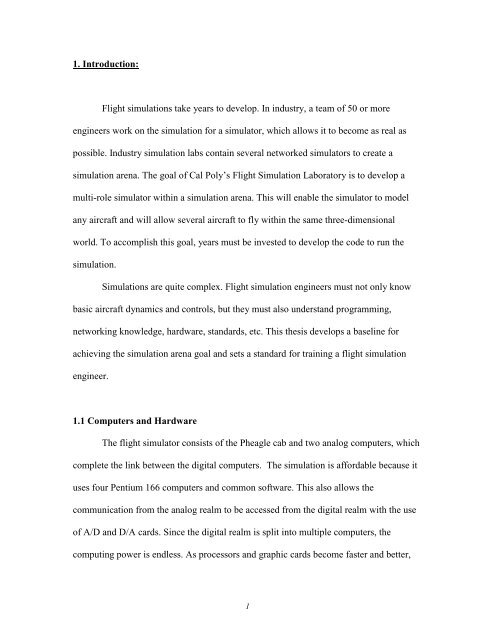Developement Of An Instrument Landing Simulation ... - Cal Poly
Developement Of An Instrument Landing Simulation ... - Cal Poly
Developement Of An Instrument Landing Simulation ... - Cal Poly
You also want an ePaper? Increase the reach of your titles
YUMPU automatically turns print PDFs into web optimized ePapers that Google loves.
1. Introduction:Flight simulations take years to develop. In industry, a team of 50 or moreengineers work on the simulation for a simulator, which allows it to become as real aspossible. Industry simulation labs contain several networked simulators to create asimulation arena. The goal of <strong>Cal</strong> <strong>Poly</strong>’s Flight <strong>Simulation</strong> Laboratory is to develop amulti-role simulator within a simulation arena. This will enable the simulator to modelany aircraft and will allow several aircraft to fly within the same three-dimensionalworld. To accomplish this goal, years must be invested to develop the code to run thesimulation.<strong>Simulation</strong>s are quite complex. Flight simulation engineers must not only knowbasic aircraft dynamics and controls, but they must also understand programming,networking knowledge, hardware, standards, etc. This thesis develops a baseline forachieving the simulation arena goal and sets a standard for training a flight simulationengineer.1.1 Computers and HardwareThe flight simulator consists of the Pheagle cab and two analog computers, whichcomplete the link between the digital computers. The simulation is affordable because ituses four Pentium 166 computers and common software. This also allows thecommunication from the analog realm to be accessed from the digital realm with the useof A/D and D/A cards. Since the digital realm is split into multiple computers, thecomputing power is endless. As processors and graphic cards become faster and better,1













